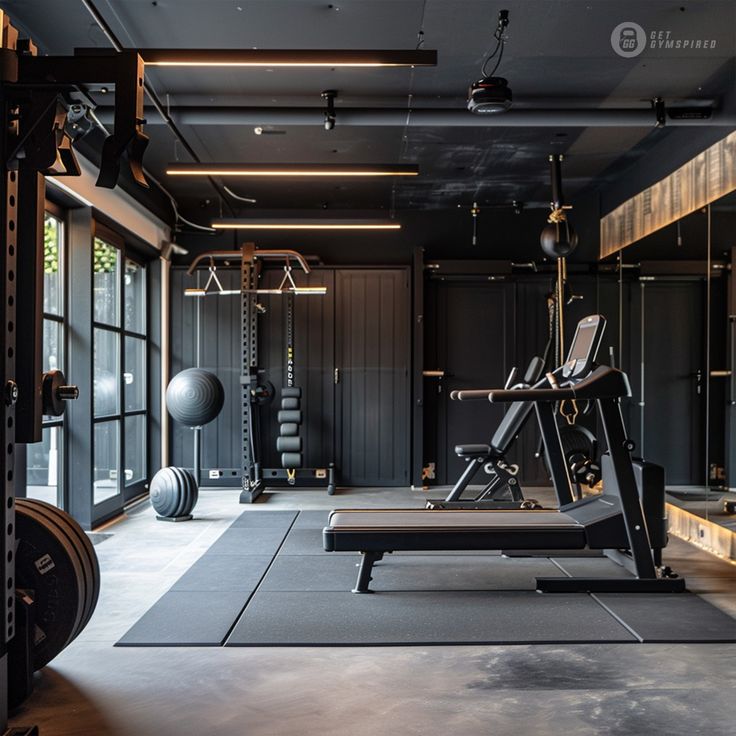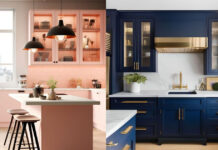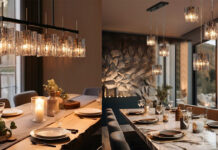Remember that feeling of wanting to get your workout on, but dreading the thought of damaging your precious floors with weights and jumping jacks? We’ve all been there. But fear not, exercise devotees! Your home gym doesn’t have to be a bare-bones space with just the essentials. The right home gym flooring can transform your workout zone into a safe, comfortable, and even stylish haven for all your fitness activities.
Think of your home gym flooring as the foundation for your fitness journey. It should be like a supportive friend – absorbing the impact of your workouts while protecting your body and, of course, your beautiful floors! So, let’s ditch the workout worries and dive into 7 innovative home gym flooring ideas:
Know Your Workout Warrior Style


Before diving headfirst into fancy home gym flooring options, consider your exercise routine. Here are some questions to ask yourself:
- High-Impact Hero? Do you love high-impact exercises like jumping jacks, burpees, or plyometrics? You’ll need a floor that absorbs shock and protects your joints.
- Low-Key Yogi? If your workouts involve yoga, Pilates, or stretching, a grippy surface for stability and comfort is key.
- Weightlifting Wonder? For weightlifting enthusiasts, a durable floor that can handle dropped weights is essential.
Material Marvels: Exploring Home Gym Flooring Ideas

Choosing the right home gym flooring depends on several factors, including:
- Location: Where will the flooring be installed? High-moisture areas like kitchens and bathrooms require water-resistant options like tile or vinyl.
- Foot traffic: Will the gym floor see heavy use? High-traffic areas like hallways and living rooms benefit from durable materials like hardwood or laminate. Lower traffic areas like bedrooms can have softer options like carpet.
- Budget: Flooring materials range in price from budget-friendly vinyl to luxurious hardwood. Determine your budget before diving into specific options.
- Style: Consider the overall aesthetic you’re aiming for. Hardwood offers a classic look, while tile can be modern or traditional depending on the design. Carpet adds warmth and comfort.
- Maintenance: Some materials require more upkeep than others. Hardwood needs occasional refinishing, while vinyl is generally easy to clean.
Here’s a quick breakdown of some popular Home Gym Flooring types to help you decide:
- Hardwood: Classic and beautiful, but requires more maintenance. Great for living rooms, bedrooms, and low-moisture areas.
- Laminate: Affordable and durable, mimics the look of wood or stone. Good for most areas except high-moisture zones.
- Tile: Water-resistant and easy to clean, perfect for kitchens, bathrooms, and laundry rooms. Wide variety of styles and materials available.
- Vinyl: Budget-friendly and versatile, comes in various styles and textures. Easy to maintain but can be susceptible to scratches.
- Carpet: Soft and comfortable, ideal for bedrooms and playrooms. Requires regular cleaning and may not be suitable for allergy sufferers.
Additional factors to consider:
- Subfloor: The existing subfloor may impact your home gym flooring choices. Uneven floors might require leveling before installation.
- Underlayment: Adding underlayment can improve soundproofing, comfort, and the lifespan of your home gym flooring.
- DIY vs. Professional Installation: Some home gym flooring types are easier to install than others. Consider your skill level and budget when deciding if professional installation is necessary.
By considering these factors and researching specific materials, you’ll be well on your way to choosing the perfect home gym flooring for your needs!
Don’t Forget the Subfloor!


The Importance of a Strong Subfloor:
- Safety: A solid subfloor is crucial for preventing unevenness or bounce, which can lead to slips, falls, and injuries during workouts.
- Durability: A strong subfloor helps distribute the weight of equipment and prevent damage to the subfloor itself, ultimately extending the lifespan of your entire home gym flooring system.
- Noise Reduction: A well-supported subfloor with proper underlayment can significantly reduce noise transmission, especially important for apartment dwellers or those who share walls with neighbors.
What to Consider When It Comes to Subfloors:
- Existing Subfloor Material: The type of home gym flooring you choose will depend on the existing subfloor material.
- Concrete: The most common and ideal subfloor for home gyms. It’s already level, stable, and can handle heavy weights. Most home gym flooringoptions can be installed directly on concrete.
- Wood Subfloors: May require additional support for heavy weights. Unevenness might need to be addressed with plywood sheets before installing your chosen flooring. Check with a professional to ensure your wood subfloor can handle the weight load you anticipate.
- Vinyl or Tile Subfloors: Generally not recommended for home gyms due to potential deflection and instability under heavy weights.
Subfloor Savvy Tips:
- Leveling Uneven Floors: If your existing subfloor isn’t perfectly level, address it before installing any home gym flooring. Self-leveling compounds or plywood sheets can be used depending on the severity of the unevenness.
- Underlayment is Your Friend: Invest in a high-quality underlayment specifically designed for home gym flooring. This adds a layer of cushion and soundproofing, further protecting the subfloor and enhancing the overall performance of your home gym flooring system.
By giving your subfloor the attention it deserves, you’ll create a safe, stable, and supportive foundation for your home gym, allowing you to focus on reaching your fitness goals with peace of mind.
Mix and Match for a Multi-Functional Marvel

Limited space doesn’t have to limit your workout potential! With a clever mix and match approach to gym flooring for home gym, you can transform your compact home gym into a multi-functional haven that caters to various exercise styles. Let’s explore how to zone out your sweat sanctuary:
The Power of Zones:
Imagine a tiny gym that feels like it has it all – a dedicated weightlifting zone for heavy lifting, a comfortable yoga area for stretching and bodyweight exercises, and maybe even a mini cardio zone for those high-intensity workouts. This magic can be achieved through strategic zoning, and gym flooring for home gym plays a starring role!
Flooring for Every Fitness Zone:
- The Weightlifting Warrior’s Zone: This is where the heavy hitters come in – barbells, dumbbells, and all. For this zone, durability is key.
- Interlocking Rubber Tiles: These classic champions are a safe bet. They absorb shock, protect your subfloor from rogue weights, and come in various thicknesses to handle even the most intense weightlifting sessions. Bonus points for exploring different colors or patterns to add a touch of personality.
- Stall Mats: Think horse stables, but way cooler (because, hello, sculpted biceps!). These thick rubber mats are incredibly affordable and durable, making them perfect for deadlifts and heavy weightlifting. Just be warned, they can be bulky and heavy to move around, so consider enlisting a friend or two for installation day.
- The Yogi’s Tranquil Territory: Namaste vibes require a comfortable and supportive surface.
- Foam Tiles: These soft and budget-friendly tiles offer excellent cushioning for yoga flows, pilates sessions, and those all-important post-workout stretches. Remember, while they provide some noise reduction, they’re not ideal for heavy weights.
- Luxury Vinyl Tiles (LVT): Some LVT options with a cushioned backing can be a good choice for yoga and bodyweight exercises. They offer a balance of comfort and support, are easy to clean, and come in a variety of styles to complement your zen aesthetic.
- The Cardio Crusader’s Corner: Get your heart pumping and blood flowing with a dedicated cardio zone.
- Gym Turf: Ever dreamt of doing sled pushes in your living room? Gym turf makes it a reality! This synthetic grass provides a realistic feel for plyometric exercises, agility drills, and those high-energy cardio sessions. Just remember, it requires special cleaning to maintain hygiene and can be a bit uneven for weightlifting.
Beyond the Basics:
The beauty of this mix-and-match approach is the endless possibilities for creating a truly unique home gym. Here are some additional tips:
- Visual Cues: Use contrasting gym flooring for home gym materials to visually define the different zones. This will help you stay focused and motivated during each workout segment.
- Double Duty with Wall Protection: Rubber bumper plates aren’t just for weightlifting! Install them on the lower sections of walls in your weightlifting zone to shield them from stray weights and kettlebell swings. It’s a space-saving solution that adds a touch of industrial chic.
- Accessorize for Inspiration: Don’t let functionality overshadow style! Hang motivational posters, display workout equipment in an organized way (think kettlebells stacked neatly in a corner), or add a pop of color with a fun yoga mat. Make your gym a space that reflects your personality and inspires you to get moving.
Which Type of Home Gym Flooring Should You Choose?

In the context of home gym flooring, choosing the right type depends on your workout style and the specific activities you’ll be doing:
High-Impact vs. Low-Impact:
- High-Impact Activities (weightlifting, plyometrics):
- Interlocking Rubber Tiles: The classic choice for a reason! They’re extremely durable, absorb shock well, and can handle dropped weights without a worry.
- Stall Mats: Super affordable and tough, these thick rubber mats are ideal for heavy weightlifting and deadlifting sessions.
- Low-Impact Activities (yoga, pilates):
- Foam Tiles: Soft and comfortable, these are perfect for floor exercises and provide some noise reduction. They’re budget-friendly and easy to install.
- Luxury Vinyl Tiles (LVT): Some LVT options with a cushioned backing offer a good balance of comfort and support for bodyweight exercises.
Other factors to consider:
- Noise Reduction: If you live in an apartment or share a wall with neighbors, noise reduction becomes crucial. Opt for thicker rubber tiles, stall mats, or LVT with soundproofing underlayment.
- Aesthetics: Don’t let functionality overshadow style! Explore patterned rubber tiles, create custom designs by mixing colors, or consider the sleek look of marble rubber flooring (though it comes with a higher price tag).
- Ease of Cleaning: Sweat happens! Choose home gym flooring that’s easy to clean and maintain. Rubber tiles, vinyl, and stall mats are all relatively low-maintenance.
Here’s a quick cheat sheet to help you decide:
| Activity | Flooring Option | Pros | Cons |
|---|---|---|---|
| Weightlifting, Deadlifts | Interlocking Rubber Tiles, Stall Mats | Extremely durable, shock-absorbent | Rubber tiles: Can be bulky, stall mats: Heavy and bulky |
| Yoga, Pilates | Foam Tiles, LVT (cushioned) | Soft, comfortable, some noise reduction | Foam tiles: Less durable, LVT: May be slippery |
| Cardio, Plyometrics | Gym Turf | Realistic feel for drills, agility training | Requires special cleaning, uneven surface for weightlifting |
Remember, you can also mix and match home gym flooring options to create designated zones for different activities in your home gym!
Maintenance Tips for Home Gym Floors


So you’ve created your dream home gym with the perfect flooring – awesome! But just like any workout routine, keeping your gym floor in top condition requires some TLC. Here are some maintenance tips to ensure your sweat sessions don’t lead to a floor in distress:
General Cleaning:
- Regular Sweeping/Vacuuming: This might seem obvious, but sweeping or vacuuming up dirt, dust, and hair regularly is key to preventing scratches and keeping your floor looking fresh. For stubborn dirt, a microfiber mop with a mild cleaning solution can be your friend.
- Frequency: The cleaning frequency depends on usage. High-traffic areas might need daily sweeps, while lower-traffic zones can be tackled a few times a week.
Deep Cleaning:
- Go Deeper for Different Materials: Each flooring type might have specific cleaning needs.
- Rubber Tiles: Mix a solution of warm water and a mild dish soap. Avoid harsh chemicals that can damage the rubber. Mop the floor and allow it to air dry completely.
- Foam Tiles: Most foam tiles are water-resistant, but avoid excessive moisture. Use a damp cloth with a mild detergent for spot cleaning. Some tiles might be machine washable – check the manufacturer’s instructions.
- Gym Turf: This requires more specific cleaning as sweat and dirt can build up in the fibers. Use a stiff brush or specialized turf cleaner to remove debris. Deep cleaning might involve a carpet cleaner with an enzyme solution (check the manufacturer’s recommendations).
- Vinyl and LVT: These are generally low-maintenance. A damp mop with a vinyl floor cleaner is usually enough. Avoid abrasive cleaners or scouring pads that can scratch the surface.
- Stall Mats: Similar to rubber tiles, use a mild soap solution and a damp mop.
- Marble Rubber Flooring: This option can be cleaned with a neutral pH stone cleaner. Avoid harsh chemicals or acidic solutions.
Prolonging the Life of Your Floor:
- Doormats: Place a sturdy doormat outside your gym entrance to trap dirt and debris before it gets tracked onto the floor.
- Shoe Policy: Consider having a designated shoe zone outside the gym area. Encourage guests (and yourself!) to swap street shoes for clean gym shoes to minimize dirt and wear.
- Lifting Platforms: For heavy weightlifting, invest in lifting platforms to distribute the weight and protect your subfloor.
- Spills and Accidents: Act fast! Clean up spills immediately to prevent stains and potential damage.
- Sunlight Exposure: Excessive sunlight can fade some flooring materials. Consider window treatments or strategic furniture placement to minimize direct sun exposure.
By following these simple maintenance tips, you can keep your home gym floor looking and performing its best, ensuring your sweat sessions are focused purely on achieving your fitness goals!
Make it Yours!


Your home gym is a reflection of your dedication to fitness. Don’t be afraid to personalize it with touches that inspire you! Hang some artwork, add a fun plant, or play your favorite workout tunes. A space that feels good will make you want to work out even harder.
Remember: Your home gym flooring doesn’t have to be an afterthought. By choosing the right options and incorporating a little creativity, you can create a safe, comfortable, and stylish space that fuels your fitness journey. So, lace up your sneakers, grab your water bottle, and get ready to sweat it out in your very own home gym haven!



























